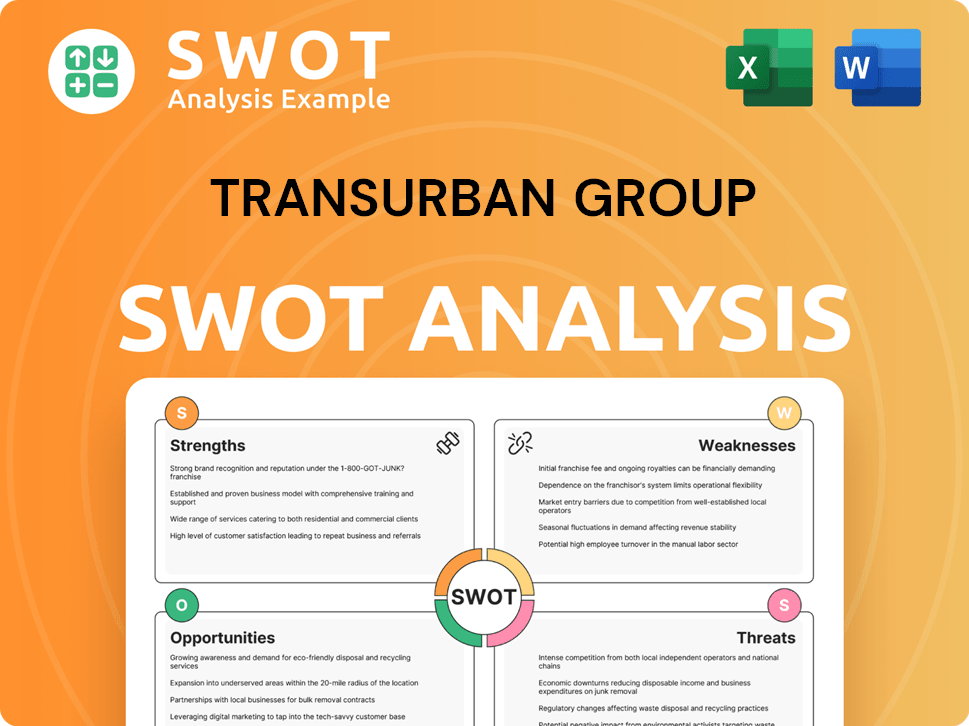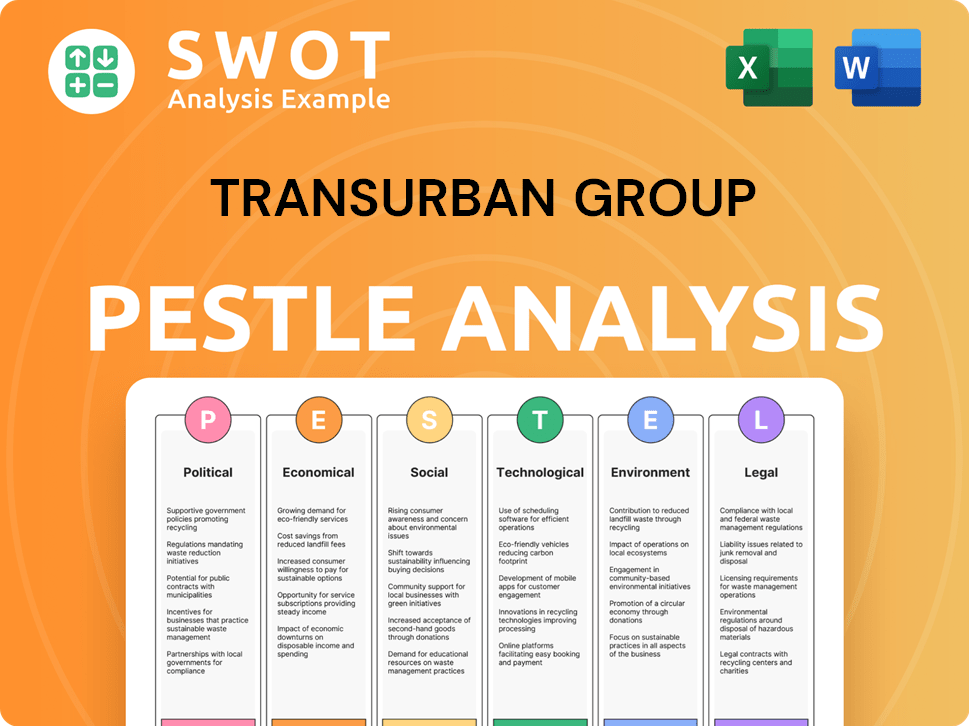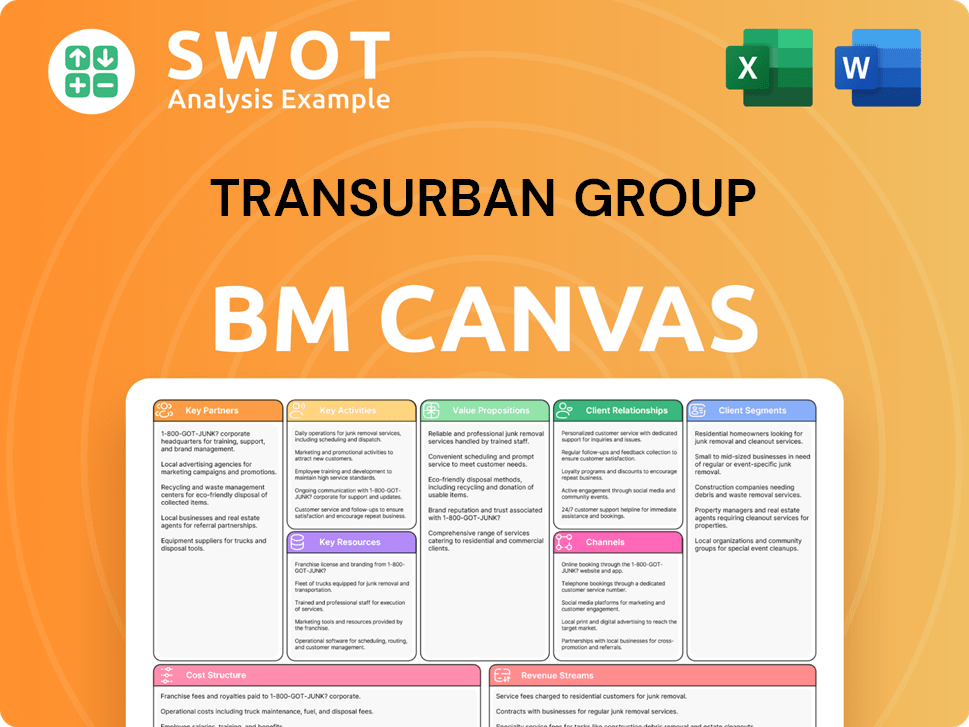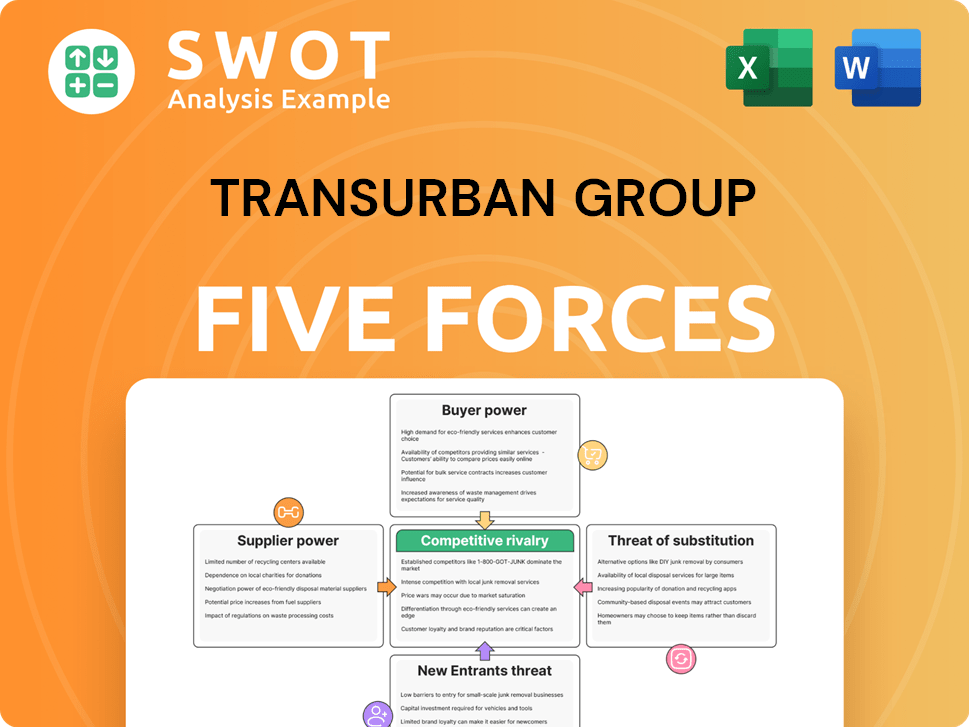Transurban Group Bundle
Who Really Controls Transurban Group?
Understanding the ownership of a company is crucial for investors and strategists alike. Knowing who owns a company reveals its strategic direction, governance, and potential for growth. This is especially true for major infrastructure players like Transurban Group, a leading toll road operator with a significant global footprint. Transurban Group SWOT Analysis can help you to understand the company's position.

Transurban Group, a key player in the infrastructure sector, has a complex ownership structure that has evolved significantly since its inception. Examining the Transurban ownership structure provides valuable insights into its operational decisions and market influence. This analysis will explore the key shareholders, the company's history, and how these factors impact the company’s future, including its ongoing Transurban projects and financial performance. Understanding who are the major shareholders of Transurban is key to understanding the company's trajectory.
Who Founded Transurban Group?
The genesis of Transurban Group dates back to 1996, when it was established and listed on the Australian Stock Exchange. Initially, the company operated under the name Transurban CityLink Limited (TCL). The primary focus was on the CityLink project in Melbourne.
The CityLink contract, awarded in 1995, was the cornerstone of Transurban's early operations. It was a joint venture between Transfield Holdings of Australia and Obayashi Corporation of Japan. The early ownership structure centered around the consortium that secured the CityLink contract.
While the exact equity split among the founders and early backers isn't readily available in public records, the company's early focus was on the CityLink project. A significant milestone occurred in 2001, when an agreement with the Victorian State Government allowed Transurban to restructure and expand its business beyond CityLink.
The company was founded in 1996 and listed on the Australian Stock Exchange on March 14, 1996. The initial listing was under the name Transurban CityLink Limited (TCL).
The company's initial purpose was the operation of the CityLink contract in Melbourne. The contract was awarded in 1995 to the Transurban Consortium.
The Transurban Consortium was a joint venture between Transfield Holdings and Obayashi Corporation. These entities were instrumental in securing the foundational project.
In 2001, an agreement with the Victorian State Government allowed Transurban to restructure. This enabled it to pursue activities beyond CityLink, leading to business expansion.
The early ownership structure primarily revolved around the consortium that secured the CityLink contract. The public listing of Transurban facilitated the operation of the project.
Detailed information regarding the specific equity split or shareholding percentages of individual founders or early backers at the company's inception is not readily available in public records.
Understanding the early structure of Transurban Group is crucial for investors. The company's initial focus on the CityLink project, secured through a consortium, set the stage for its future. The subsequent public listing and restructuring in 2001 were pivotal in shaping the company's growth. For a deeper dive into the company's operations, consider exploring the Revenue Streams & Business Model of Transurban Group. Analyzing the initial ownership structure and subsequent changes provides valuable insights for anyone interested in Transurban ownership, Transurban shareholders, and the evolution of Transurban infrastructure projects.
The early days of Transurban were centered on the CityLink project and the consortium that secured it.
- Founded in 1996 and listed as Transurban CityLink Limited.
- The initial focus was the operation of the CityLink contract in Melbourne.
- The Transurban Consortium was a joint venture between Transfield Holdings and Obayashi Corporation.
- Restructuring in 2001 allowed for expansion beyond CityLink.
Transurban Group SWOT Analysis
- Complete SWOT Breakdown
- Fully Customizable
- Editable in Excel & Word
- Professional Formatting
- Investor-Ready Format

How Has Transurban Group’s Ownership Changed Over Time?
Since its initial public offering (IPO) on March 14, 1996, the ownership structure of Transurban Group has undergone significant changes, mirroring its evolution into a leading publicly traded infrastructure company. As of May 7, 2025, the majority of Transurban's shares are held by institutional investors, who significantly influence the company's strategic direction and voting outcomes. These institutional holdings, accounting for over half of the total shares, include investments from superannuation funds and various investment firms, which helps to stabilize the company.
The evolution of Transurban's ownership reflects its growth and adaptation in the infrastructure sector. The company's ability to attract and retain significant institutional investment demonstrates its strong market position and potential for long-term value creation. Understanding the dynamics of Transurban ownership is crucial for investors and stakeholders interested in the company's performance and strategic direction. For more insights, consider exploring the Growth Strategy of Transurban Group.
| Shareholder | Shares Held (as of May 9, 2025) | Percentage of Ownership |
|---|---|---|
| UniSuper Limited | 321,615,724 | 10.40% |
| AustralianSuper Pty Ltd. | 158,073,392 | 5.085% |
| BlackRock Fund Advisors | 77,356,596 | 2.489% |
Among the primary stakeholders, UniSuper Limited holds the largest individual stake, with 10.40% or 321,615,724 shares as of May 9, 2025, though this decreased from a previous notice on July 23, 2024. Other significant institutional shareholders include AustralianSuper Pty Ltd. with 5.085% (158,073,392 shares), BlackRock Fund Advisors with 2.489% (77,356,596 shares), and The Vanguard Group, Inc. Collectively, the top three shareholders control a dominant portion of the overall ownership, reaching approximately half of the company's total shares, which supports balanced corporate governance by preventing any single entity from achieving excessive dominance. The general public also retains a substantial segment of ownership, contributing to the broader investor base and playing a role in resolutions requiring wider consensus.
Transurban Group's ownership structure is primarily influenced by institutional investors.
- UniSuper Limited is the largest single shareholder.
- The top three shareholders control a significant portion of the company.
- The public also holds a substantial ownership segment.
- Understanding Transurban ownership is vital for stakeholders.
Transurban Group PESTLE Analysis
- Covers All 6 PESTLE Categories
- No Research Needed – Save Hours of Work
- Built by Experts, Trusted by Consultants
- Instant Download, Ready to Use
- 100% Editable, Fully Customizable

Who Sits on Transurban Group’s Board?
The corporate governance of Transurban Group is designed to ensure transparency and accountability, with the Board of Directors at its core. The Board oversees the company's performance and strategic direction. As of June 13, 2025, the Board includes Mr. Craig Drummond as Independent Non-Executive Chairman and Ms. Michelle Jablko as Chief Executive Officer and Managing Director, who was appointed in October 2023. The separation of the Chair and CEO roles promotes independent judgment, which is a key aspect of the company's governance structure. The company's focus is on Growth Strategy of Transurban Group.
Other Non-Executive Directors include Ms. Patricia Anne Cross, Mr. Peter Brooke Scott, Mr. Timothy John Reed, Dr. Sarah Elizabeth Ryan, Mr. Mark Birrell, Ms. Marina Simone Go, Mr. Robert John Whitfield, and Mr. Gary Andrew Lennon, appointed on March 18, 2024. For example, Ms. Patricia Anne Cross's role as a Non-Executive Director of Transurban Ltd illustrates the connections between board members and the company's operations. The board composition reflects a commitment to diverse expertise and independent oversight, crucial for managing Transurban's infrastructure projects and ensuring responsible Transurban ownership.
| Board Member | Position | Appointment Date |
|---|---|---|
| Mr. Craig Drummond | Independent Non-Executive Chairman | N/A |
| Ms. Michelle Jablko | Chief Executive Officer and Managing Director | October 2023 |
| Ms. Patricia Anne Cross | Non-Executive Director | N/A |
| Mr. Peter Brooke Scott | Non-Executive Director | N/A |
| Mr. Timothy John Reed | Non-Executive Director | N/A |
| Dr. Sarah Elizabeth Ryan | Non-Executive Director | N/A |
| Mr. Mark Birrell | Non-Executive Director | N/A |
| Ms. Marina Simone Go | Non-Executive Director | N/A |
| Mr. Robert John Whitfield | Non-Executive Director | N/A |
| Mr. Gary Andrew Lennon | Non-Executive Director | March 18, 2024 |
Transurban operates under a stapled security structure, which consolidates financial reporting for Transurban Holdings Limited (THL), Transurban International Limited (TIL), and Transurban Holding Trust (THT). In voting on resolutions, each member of THT has one vote for each dollar of their total interests in THT. While board and executive ownership is typically minimal, consistent with companies of similar size, there has been an increase in executive-level share acquisition, aligning with standard equity participation practices. The company's corporate governance statement for the year ended June 30, 2024, confirms compliance with the ASX Corporate Governance Council's Principles and Recommendations. This structure impacts how Transurban shareholders exercise their voting rights and influences the company's strategic decisions. The focus on governance is essential for the company's financial performance and for investors looking to invest in Transurban stock.
Transurban Group's governance emphasizes transparency and accountability.
- Independent Board with separate Chair and CEO roles.
- Stapled security structure affecting voting rights.
- Compliance with ASX Corporate Governance Council's Principles.
- Focus on responsible Transurban infrastructure management.
Transurban Group Business Model Canvas
- Complete 9-Block Business Model Canvas
- Effortlessly Communicate Your Business Strategy
- Investor-Ready BMC Format
- 100% Editable and Customizable
- Clear and Structured Layout

What Recent Changes Have Shaped Transurban Group’s Ownership Landscape?
In the past few years, Transurban Group has undergone significant changes impacting its ownership and operational strategies. A key development was the announcement of a new operating model in May 2024, leading to organizational restructuring. This included creating new executive roles and a workforce review that resulted in approximately 300 employees leaving the company by May 2025 to streamline operations. These adjustments reflect the company's efforts to adapt and improve its operational efficiency.
Financially, Transurban reported a robust performance in FY24. Proportional toll revenue increased by 6.7% to $3,535 million, and EBITDA rose by 7.5% to $2,631 million. The company reaffirmed its FY25 distribution guidance at 65.0 cents per stapled security. Average Daily Traffic (ADT) across the Group saw a 1.8% increase in the March quarter of 2025, averaging 2.5 million trips per day. These figures highlight the company’s strong financial health and operational growth within the Transurban infrastructure sector.
| Metric | Value | Date |
|---|---|---|
| Proportional Toll Revenue | $3,535 million | FY24 |
| EBITDA | $2,631 million | FY24 |
| ADT Growth | 1.8% | March Quarter 2025 |
Ownership trends continue to indicate strong institutional holdings. As of May 12, 2025, institutional owners held a total of 343,564,714 shares. Major institutional shareholders include Vanguard Total International Stock Index Fund, Lazard Global Listed Infrastructure Portfolio, and iShares Global Infrastructure ETF. The stock price as of May 12, 2025, was $14.27 per share, a 9.90% increase since October 30, 2024. The debt/equity ratio for FY24 was 175.1%, and the average dividend yield over the last five years was 3.6% per year. These details provide insights into the company's shareholder base and financial leverage.
Organizational restructuring and workforce adjustments, including the creation of new executive roles.
Strong revenue and EBITDA growth in FY24, with reaffirmed distribution guidance for FY25.
Significant institutional ownership, with major shareholders including Vanguard and Lazard.
The stock price increased by 9.90% since October 30, 2024, with a debt/equity ratio of 175.1% for FY24.
Transurban Group Porter's Five Forces Analysis
- Covers All 5 Competitive Forces in Detail
- Structured for Consultants, Students, and Founders
- 100% Editable in Microsoft Word & Excel
- Instant Digital Download – Use Immediately
- Compatible with Mac & PC – Fully Unlocked

Related Blogs
- What are Mission Vision & Core Values of Transurban Group Company?
- What is Competitive Landscape of Transurban Group Company?
- What is Growth Strategy and Future Prospects of Transurban Group Company?
- How Does Transurban Group Company Work?
- What is Sales and Marketing Strategy of Transurban Group Company?
- What is Brief History of Transurban Group Company?
- What is Customer Demographics and Target Market of Transurban Group Company?
Disclaimer
All information, articles, and product details provided on this website are for general informational and educational purposes only. We do not claim any ownership over, nor do we intend to infringe upon, any trademarks, copyrights, logos, brand names, or other intellectual property mentioned or depicted on this site. Such intellectual property remains the property of its respective owners, and any references here are made solely for identification or informational purposes, without implying any affiliation, endorsement, or partnership.
We make no representations or warranties, express or implied, regarding the accuracy, completeness, or suitability of any content or products presented. Nothing on this website should be construed as legal, tax, investment, financial, medical, or other professional advice. In addition, no part of this site—including articles or product references—constitutes a solicitation, recommendation, endorsement, advertisement, or offer to buy or sell any securities, franchises, or other financial instruments, particularly in jurisdictions where such activity would be unlawful.
All content is of a general nature and may not address the specific circumstances of any individual or entity. It is not a substitute for professional advice or services. Any actions you take based on the information provided here are strictly at your own risk. You accept full responsibility for any decisions or outcomes arising from your use of this website and agree to release us from any liability in connection with your use of, or reliance upon, the content or products found herein.